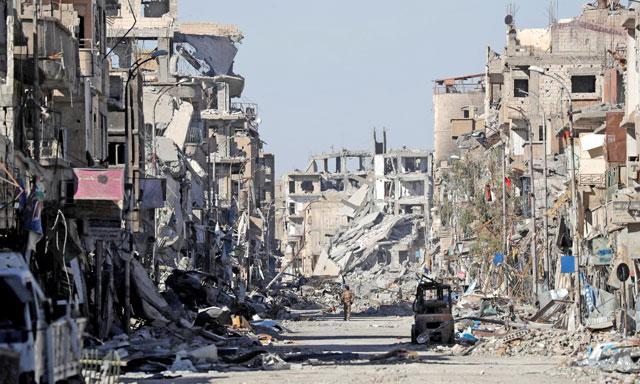
Terrain, geopolitics make for tricky last battle on Daesh
After losing their main hubs of Mosul and Raqqa this year, the noose continued to tighten around holdout Daesh fighters regrouping in the badlands where the organisation was born.
On Thursday, Iraqi Prime Minister Haider Al Abadi, announced an assault in the last areas of Anbar province where Daesh retains a foothold, further turning up the heat on the extremists' routed remnants.A key target of the latest Iraqi operation is Al Qaim, one of the last towns of note still under extremist control in Iraq.
Syrian regime forces and allied militia groups still have some ground to cover before reaching Albu Kamal, which is Al Qaim's twin town on the Syrian side of the border.The group that ruled over a 'state' covering roughly the size of Britain only three years ago appears to be on its last legs but the final battle to retake its remote border heartland could be a tough one.
'The geography and the society in this area are distinct from elsewhere... they make for a tougher terrain. It is difficult to navigate,' said analyst Hassan Hassan, author of an acclaimed book on Daesh.The areas beyond the immediate fertile strip flanking the Euphrates river are arid and remote, Sunni Arab tribal hinterlands that always escaped central authority to some extent.
'It is more complicated than other regions because this is where Daesh emerged back in the day,' Hassan said of the restive region, where the population is traditionally hostile to both President Bashar Assad and the Kurds.'Easy part'
Iraqi and Syrian government forces lack deep knowledge of the terrain there or local partners they can heavily rely on, such as the US-backed force that retook the extremist stronghold of Raqqa last week.
That Kurdish-led alliance will be involved in the final assault on Daesh but only further north, in mostly desert areas between the Syrian cities of Deir Ezzor and Hasakeh.
Iraqi federal forces are advancing with fighters from Hashed Al Shaabi, a paramilitary organisation dominated by Shiite militias loyal to Iran.On the other arm of the pincer closing in on the extremists are Syrian regime forces, that are at least 50 kilometres from Albu Kamal and supported by Iraqi, Iranian, Lebanese and Afghan militia.
The last Daesh bastions to fall are likely to be on the Syrian side where — according to Christopher Meserole, a fellow at the Centre for Middle East Policy at Brookings, and several other analysts — the group still has an estimated 5,000 fighters.Yet, the extremists have already begun reverting to an insurgency that could thrive if the disparate victors of the 'caliphate' fail to work together in the region.
'Defeating the Daesh will be the easy part,' said Meserole. 'The hard part will be securing the peace, making sure that the forces converging on Deir Ezzor don't start fighting among themselves.''The stakes for Deir Ezzor could not be higher,' he said of the oil-rich eastern Syrian province which, unlike Raqa, was a priority of recent military efforts by regime.
'The Iranians want an overland route to the Mediterranean. The Kurds want a buffer between Assad's forces and their territory further to the north. In some ways, the situation is like the end of World War II, when Soviet and American forces converged on Berlin.'Fabrice Balanche, a visiting fellow at Stanford University's Hoover Institution, argued that the United States had already almost lost that contest.
'The United States and their allies wanted to take the Iraqi-Syrian border. They wanted to create an Arab force capable of running this area, that also would have cut the corridor the Iranians are building,' he said.
'But they don't have the means to do that, or indeed maybe not the will. [US President Donald] Trump appears to want to get rid of the Daesh and not see any further.'

Legal Disclaimer:
MENAFN provides the
information “as is” without warranty of any kind. We do not accept
any responsibility or liability for the accuracy, content, images,
videos, licenses, completeness, legality, or reliability of the information
contained in this article. If you have any complaints or copyright
issues related to this article, kindly contact the provider above.


















Comments
No comment